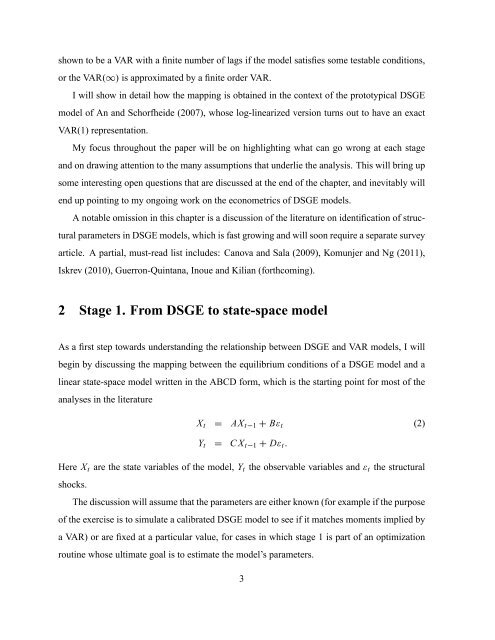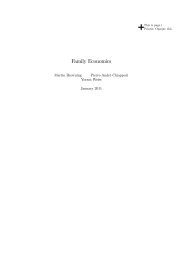The relationship between DSGE and VAR models - cemmap
The relationship between DSGE and VAR models - cemmap
The relationship between DSGE and VAR models - cemmap
Create successful ePaper yourself
Turn your PDF publications into a flip-book with our unique Google optimized e-Paper software.
shown to be a <strong>VAR</strong> with a nite number of lags if the model satises some testable conditions,<br />
or the <strong>VAR</strong>.1/ is approximated by a nite order <strong>VAR</strong>.<br />
I will show in detail how the mapping is obtained in the context of the prototypical <strong>DSGE</strong><br />
model of An <strong>and</strong> Schorfheide (2007), whose log-linearized version turns out to have an exact<br />
<strong>VAR</strong>(1) representation.<br />
My focus throughout the paper will be on highlighting what can go wrong at each stage<br />
<strong>and</strong> on drawing attention to the many assumptions that underlie the analysis. This will bring up<br />
some interesting open questions that are discussed at the end of the chapter, <strong>and</strong> inevitably will<br />
end up pointing to my ongoing work on the econometrics of <strong>DSGE</strong> <strong>models</strong>.<br />
A notable omission in this chapter is a discussion of the literature on identication of structural<br />
parameters in <strong>DSGE</strong> <strong>models</strong>, which is fast growing <strong>and</strong> will soon require a separate survey<br />
article. A partial, must-read list includes: Canova <strong>and</strong> Sala (2009), Komunjer <strong>and</strong> Ng (2011),<br />
Iskrev (2010), Guerron-Quintana, Inoue <strong>and</strong> Kilian (forthcoming).<br />
2 Stage 1. From <strong>DSGE</strong> to state-space model<br />
As a rst step towards underst<strong>and</strong>ing the <strong>relationship</strong> <strong>between</strong> <strong>DSGE</strong> <strong>and</strong> <strong>VAR</strong> <strong>models</strong>, I will<br />
begin by discussing the mapping <strong>between</strong> the equilibrium conditions of a <strong>DSGE</strong> model <strong>and</strong> a<br />
linear state-space model written in the ABCD form, which is the starting point for most of the<br />
analyses in the literature<br />
X t D AX t 1 C B" t (2)<br />
Y t D C X t 1 C D" t :<br />
Here X t are the state variables of the model, Y t the observable variables <strong>and</strong> " t the structural<br />
shocks.<br />
<strong>The</strong> discussion will assume that the parameters are either known (for example if the purpose<br />
of the exercise is to simulate a calibrated <strong>DSGE</strong> model to see if it matches moments implied by<br />
a <strong>VAR</strong>) or are xed at a particular value, for cases in which stage 1 is part of an optimization<br />
routine whose ultimate goal is to estimate the model's parameters.<br />
3













